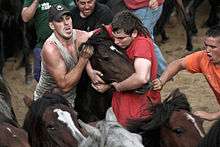Rapa das Bestas


Rapa das Bestas (The Capture of the Beasts)[1] is the name of an operation that involves cutting the manes of the wild horses who live free at the mountains in a semi-feral state and that are performed in the curros (enclosed which retain the horses) held in various locations in Galicia (Spain). Those horses live in mountains owned by the villages (a form of property derived from the Suevi, around 8th century) and have several owners (private owners, the parish or the village), each year the foal are marked and the adults shaved and deloused, and then freed again to the mountains.
The best known is the Rapa das Bestas of Sabucedo, in the city hall of A Estrada, which lasts three days: the First Saturday, Sunday and Monday in July. In fact, the name given to the celebration (Rapa das Bestas of Sabucedo), while in most places speaking about curros, including curros de Valga, etc.
Locations
| | |
| | |
| A Capelada (Cedeira) | June 29 |
| As Canizadas (A Pobra do Caramiñal) | July 12 to 19 |
| Campo da Areosa (Vimianzo) | Mid-July |
| | |
| Candaoso (Viveiro) | First Sunday of July |
| Campo do Oso (Mondoñedo) | Last Sunday of July |
| San Tomé (O Valadouro) | First Sunday of August |
| | |
| Mougás (Oya) | June 8 |
| Morgadáns (Gondomar) | June 15 |
| San Cibrán (Gondomar) | June 22 |
| Sabucedo (A Estrada) | First Saturday of July |
| Monte Castelo (Cotobade) | August 3 |
| Domaio (Moaña) | August 13 |
| Paradanta (A Cañiza) | August 31 |
| O Galiñeiro (Gondomar) | August |